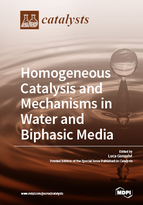Homogeneous Catalysis and Mechanisms in Water and Biphasic Media
A special issue of Catalysts (ISSN 2073-4344). This special issue belongs to the section "Catalytic Materials".
Deadline for manuscript submissions: closed (31 December 2017) | Viewed by 53003
Special Issue Editor
Interests: organometallics and catalysis in water and biphasic systems; CO2 activation and utilization processes; hydrogen activation, production, and storage by organometallics; homogeneous catalysis; catalytic mechanisms
Special Issues, Collections and Topics in MDPI journals
Special Issue Information
Dear Colleagues,
After its discovery in the early 1980s and successful application on an industrial scale (SHOP and Ruhrchemie/Rhône-Poulenc processes), water phase and biphasic catalysis have been the subject of fundamental studies in a relatively limited number of research laboratories around the world, almost at a curiosity level. During the last 15 years, however, this topic has witnessed a true renaissance, mainly due to the increased attention of industry and academia to more environmentally friendly processes. Water is the green solvent par excellence, and a great deal of research has been carried out to convey the properties of known transition metal catalysts to their water-soluble analogs, maintaining high activities and selectivities. The keys to success have been, among others, the discovery of synthetic pathways to novel molecular and nanosized metal-based catalysts, new mechanistic insights in the role of water as non-innocent solvent, the identification of reaction pathways by experimental and theoretical methods, and the application of novel concepts for phase transfer agents in biphasic catalysis.
In this Special Issue, the latest achievements in synthetic ligand and catalyst modifications, applications to selected substrate activation related to bulk chemicals, commodities and energy vectors, such as hydrogen, will be highlighted, together with recent mechanistic studies, unconventional approaches, and engineering solutions.
Dr. Luca Gonsalvi
Guest Editor
Manuscript Submission Information
Manuscripts should be submitted online at www.mdpi.com by registering and logging in to this website. Once you are registered, click here to go to the submission form. Manuscripts can be submitted until the deadline. All submissions that pass pre-check are peer-reviewed. Accepted papers will be published continuously in the journal (as soon as accepted) and will be listed together on the special issue website. Research articles, review articles as well as short communications are invited. For planned papers, a title and short abstract (about 100 words) can be sent to the Editorial Office for announcement on this website.
Submitted manuscripts should not have been published previously, nor be under consideration for publication elsewhere (except conference proceedings papers). All manuscripts are thoroughly refereed through a single-blind peer-review process. A guide for authors and other relevant information for submission of manuscripts is available on the Instructions for Authors page. Catalysts is an international peer-reviewed open access monthly journal published by MDPI.
Please visit the Instructions for Authors page before submitting a manuscript. The Article Processing Charge (APC) for publication in this open access journal is 2700 CHF (Swiss Francs). Submitted papers should be well formatted and use good English. Authors may use MDPI's English editing service prior to publication or during author revisions.
Keywords
-
Water phase catalysis
-
Catalysis in biphasic systems
-
Mechanistic studies
-
Theoretical studies
-
C-Element bond activation in water
-
Water soluble organometallic compounds
-
Water soluble ligands and applications
-
Small molecules activation in water
-
Green chemistry






